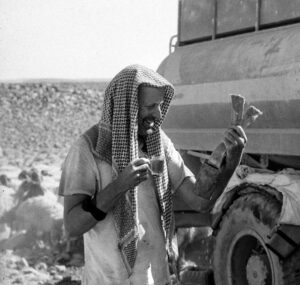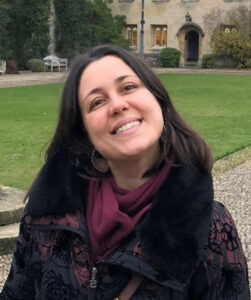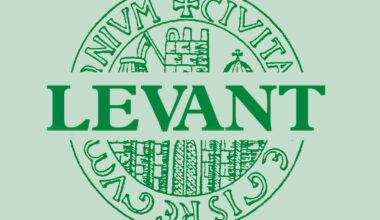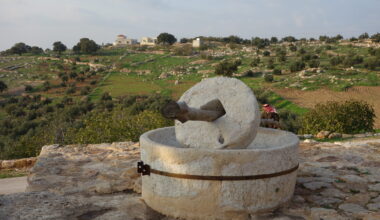We are thrilled to announce the winners of the 2024 Levant Summer Prizes!
Launched in 2022, CBRL’s international peer-reviewed journal Levant offers two annual prizes for Best Paper and Early Career Best Paper, which recognise excellent research and scholarship on the archaeology and history of the Levant region, its diasporas and neighbouring countries (prehistory–Ottoman). For more about the aims and scope of Levant, please see here.
Best Paper Prize Winner
Alex Wasse
Not a place for respectable people, but the ends of the earth converge there: insights from Wisad Pools into the nature and context of Jordan’s Black Desert Neolithic
Co-written with Gary Rollefson, Yorke Rowan, Blair Heidkamp, Louise Martin, Tom Röttger-Morgan and Özlem Sarıtaş.
The paper is available to read here

“We’re honoured to have been awarded the Levant Summer Prize for 2024. The Eastern Badia Archaeological Project has been active in one form or another for more than 20 years, during which time it has contributed to the development of an increasingly fine-grained understanding of one of Jordan’s most spectacular prehistoric landscapes. The remoteness of the study area and remarkable state of preservation of its innumerable Neolithic structures bring unique challenges that can sometimes make for slow progress. At the same time, it is our belief that these reward a steady, incremental approach to the research process, not least through the building of long-term academic and local-community partnerships. The award of this prize will contribute to the archaeological, ecological and living heritage of what we’ve come to regard as the jewel in the crown of Jordan’s many attractions gaining greater public awareness and, we hope, greater protection. For this we are profoundly grateful.” Alex Wasse
Judges comments: This paper presented exciting, but also very impactful, new data, data which continues to challenge current interpretations of Neolithization and the importance of the Badia. They also thought the paper a great example of literature that combines a variety of different evidence (e.g., climatic, excavation, landscape) and does so effectively. It also places the discussions within broader questions and current debates (e.g., links with Arabia) all of which made for an excellent paper.
Early Career Best Paper Winner
Giuila Muti
Discoid loom weights on Cyprus: new insights into textile tools and practical knowledge from the Aegean.
The paper is available to read here

“I am deeply honoured to have been awarded the 2024 Levant Summer Prize for Early Career Best Paper. This recognition shows that the study of textile tools can contribute significantly to broader narratives on connectivity, circulation and transmission, bringing these artefacts out of their niche. I am grateful to the committee members for their trust in my work and to all the mentors and colleagues who have supported my research as well as the institutions that made it possible—the Department of Antiquities, Cyprus, the Medelhavsmuseet and CAARI. I look forward to continuing researching this topic and am pleased that the paper will be open access, allowing the Cypriot discoid loom weights to travel the digital sea and reach a wider audience.” Giulia Muti
Judges comments: This is an excellent paper and the author did a great job at presenting and re-analysing an understudied type of material culture (loom weights). Their observations and ideas were carefully thought out and discussed. I also thought they did a great job at contextualizing their findings and pointed towards the wider importance and significance of their research. They also nicely engaged with current debates around internationalism, Minoanization and craft practices on LBA Cyprus.
Both papers are currently free to view and accessible via the T&F website. Below are the abstracts of the winning papers:
Not a place for respectable people, but the ends of the earth converge there: insights from Wisad Pools into the nature and context of Jordan’s Black Desert Neolithic by Alexander Wasse, Gary Rollefson, Yorke Rowan, Blair Heidkamp, Louise Martin, Tom Röttger-Morgan and Özlem Sarıtaş
New data, recovered by the Eastern Badia Archaeological Project, from substantial structures at Wisad Pools have provided insights into the nature and context of eastern Jordan’s Black Desert Neolithic cultural complex, dating to between c. 7000 and 5000 cal. BC. Hunter-herder-trapper communities, with economies based partially on ante-mortem exploitation of domestic sheep, were adept at maintaining a balance between local and non-local adaptations in shaping a networked culture that was deeply rooted in its local environment. Evidence for trans-regional connections with the Levant and Mesopotamia raises the possibility that longer-term habitation sites, like Wisad Pools, were instrumental in linking the western and eastern arms of the Fertile Crescent via direct routes across the steppe. At least one structure excavated by the Project displays evidence for sophisticated architectural planning, demonstrating awareness of basic geometric principles. New radiometric assays suggest that processes of change were profoundly influenced by episodes of climatic and environmental change, including the longer 8.2 ka event. Emerging data from north-west Saudi Arabia require the Wisad Pools to be examined in the context of Arabian Neolithization, considering the possibility that the Black Desert Neolithic was a point of departure for some aspects of that process.
Discoid loom weights on Cyprus: new insights into textile tools and practical knowledge from the Aegean by Giulia Muti
Discoid loom weights are a distinctive type of weaving tool widely found at Bronze Age sites across the Aegean region. The identification of these artefacts in the Cypriot record sheds new light on the contacts between the island and the Aegean at the dawn of the Late Bronze Age. This paper aims to analyse the earliest examples of Cypriot discoid loom weights, retrieved from early Late Bronze Age contexts at Kalopsidha and Enkomi. The study focuses on their function and implications concerning the adoption of new weaving tools and likely practices within a period of profound social and economic transformations on the island. While transfers of technologies and practices to Cyprus are largely hypothesized for the various changes reflected in the material culture of this period, the transmission dynamics remain largely unknown. Therefore, discoid loom weights provide us with a new perspective from which to examine the mechanisms of the spread of tools and practical knowledge to the island during this crucial period.














